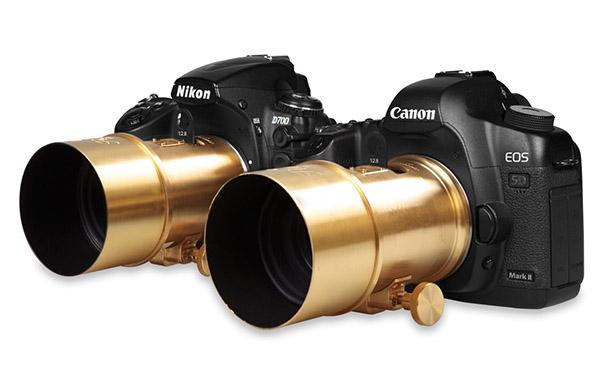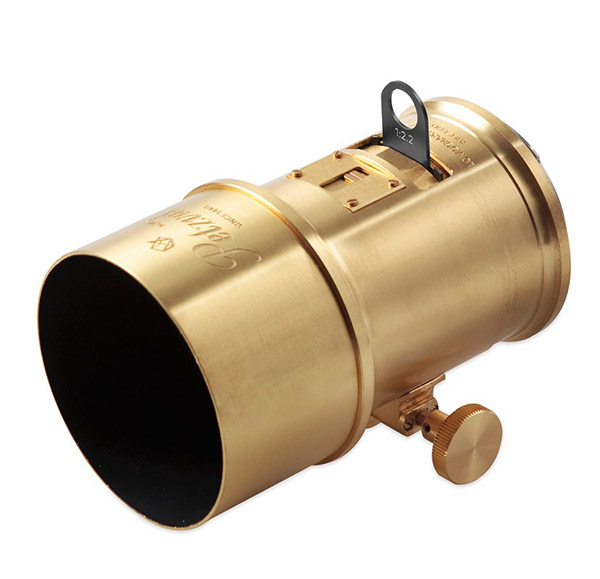I just bought my Petzval 85 and find that when using the screen I have to set my shutter speed very low so that I have enough light to focus and then speed it up to get the correct exposure. When I do that the screen is under exposed and I can't see the subject. Have you run into this?
Thanks,
Pat
Lomography Petzval 85mm f/2.2 Art Lens Review

As a lover of all things unsharp, I was eager to get my mitts on a Petzval 85mm portrait lens. When I saw it at Photo Plus Expo here in New York, it was under glass, gleaming like a gilded idol. The fine folks at Lomography were kind enough to loan me a sample. What follows is my report.
The Petzval 85mm f/2.2 is a manual, creative focus portrait lens available in fixed mounts for Canon and Nikon DSLRs. It’s based on a design that was created more than 150 years ago. Frankly, I have never seen an original Petzval, but I can testify that this modern remake is faithful to the photos I seen of the 1840 model.
The luxuriously finished box is marked, “Petzval – since 1840.” That’s a bit misleading, sort of like selling a replica of a Spondylosoma dinosaur and labeling it “since 235 million BC.” They’re manufactured in Russia by Zenit, a name well known to photographers as the producer of Leica counterfeits of varying quality. The driving force behind it here in the US is the same that brought us Lomography and all of those wonderful, zany analog cameras, lenses and photo gadgets.

The Petzval 85mm lens is made of brass. In fact, all visible parts are shiny, gold-colored brass. It’s attractive, in the literal sense, in that civilians may stare at you and wonder which planet you’re from. Brass has two disadvantages that I know of (there may be more). Brass is heavy. This lens weighs nearly as much as my Canon 5D Mk II body, about 1.5 pounds. Brass also loses its shiny appearance and acquires an uneven patina over the course of time. That’s not a bad thing necessarily, and I suppose that if you didn’t like the greenish tinge it takes on you could always keep it polished and clean.
Attachment to my Canon full-frame DSLR was easy but unsatisfactory. There was a noticeable wobble. Whereas other lenses and adapters snap onto my camera like the hatch on a submarine closing, the Petzval fit more like a loose wooden screen door. This was surprising because except for this I had been initially impressed by the finish and workmanship of the exterior. Upon closer examination, however, I discovered several sharp edges in the coined areas on top near the focusing distance scale and sharp corners on the scale itself.

Focusing is manual, of course, and uses a tooth-and-gear system. The focusing knob, which is about three-quarters of an inch in diameter, rotates only one-quarter of a turn over the entire focusing range (1 meter to infinity). As a result, precise focus is difficult if not impossible when shooting wide-open at f/2.2. One could use a smaller aperture plate to increase depth-of-field thereby masking the lack of precision, but that rather defeats the purpose of using this lens instead of a more sensible one. You might say that accurate focus occurs more-or-less by accident.

The shot immediately above was made at f/11 on a Canon 5D Mk II and processed to monochrome to show that the lens can be coaxed into sharpness. But then again, you’d never buy this lens to shoot this kind of image.

The aperture diaphragm is controlled via a set of seven small, thin metal plates that are inserted into a one-inch long slot on the top of the lens. A blank plate, i.e., one without a hole, is supplied presumably to keep the slot closed to dust when the lens in not in use. (If I owned this lens I’d use electrical tape.) Apertures of this type are known as “Waterhouse stops,” allegedly first conceived by a photographer with the same name. They offer the advantage of a circular opening, unlike apertures created by diaphragm blades which are generally (but not always) multisided polygons.
The plate for the largest aperture, f/2.2, appears to be anodized. That’s good because the others are coated with enamel or some material that shaves off and collects as objectionable dust every time the plate is inserted through the sharp edges of the slot. I did not disassemble this lens, but I’m guessing the dust accumulates inside as well.
When the focusing rail is racked to the closest position or all the way back to infinity, the aperture plate is pinned against the straight-walled, coined depression that surrounds it. This exacerbates the flaking tendency mentioned above and also makes it slightly difficult (and completely unpleasant) to remove the plate to change aperture.

I lost two of the plates—not permanently, but throughout an entire shoot—because I couldn’t find which pocket I’d put them in. They are about half the size of a matchbook (if you’re old enough to remember book matches) and as thin as a business card. The Petzval came with a leather pouch—a heavy duty affair, the type that Daniel Boone might have worn on his belt to carry buckshot—but it was impractical to use as a home for the aperture plates.
Lens performance was exciting but inconsistent. Some of the out-of-focus backgrounds came out pleasant and understated, but others were just mush. The experience overall would have been better if the outcome had been more controllable and predictable. You’re probably a better photographer than I am, so your may be able to get more out of this lens than I could.

The Petzval 85mm f2.2 Art Lens includes seven standard aperture plates (f/2.2 through f/11), a cleaning cloth, brass lens cap, leather pouch and nicely done Petzval book. It’s available from the Lomography Online Shop, any of their 25 Gallery & Embassy Stores and other merchants for $599. At the time of this writing, the genuine Canon 85mm f/1.8 lens is widely available for $349. Many will find this cost discrepancy too high a hurdle to justify.
—Jon Sienkiewicz

- Log in or register to post comments


















































